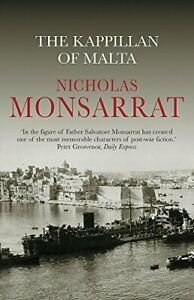The Kappillan of Malta
by Nicholas Monsarrat
In 1942, the Island of Malta was awarded the Victoria Cross by King George VI. During the Siege of Malta, from June 1940 to August 1942, the people endured both continual bombardment and starvation as nearly every supply ship or convoy was sunk and the island reduced to rubble. What the people of Malta suffered during this time beggars belief.
The Siege of Malta is the backdrop for Monsarrat’s The Kappillan of Malta. Father Salvatore, or Dun Salv as his parishioners call him, is a local parish priest. The bombs open some forgotten catacombs, a resting place for monks who died centuries ago. As homes are destroyed and fear fills the city, many Maltese take refuge here – up to 6000 at one stage – and Father Salvatore joins them, becoming the priest (or kappillan) of the catacombs.
Life is never simple, especially during a war. Father Salvatore’s mother is the Baroness Celeste Santo-Nobile, head of an old and noble family. Despite her age, she refuses to leave her home, a palace which has played host to popes and kings. Aside from Father Salvatore, the Baroness has two other children. One son, Benedict, is in Paris, rumoured to be holding parties with the German occupiers. Her daughter is married to a socialite lawyer, a prominent Italian sympathiser who will be arrested before the war is far advanced.
Yet through the eyes of Dun Salv, Monsarrat writes of these failings with a loving tenderness. In the same way Father Salvatore cares for his people. He is a man steeped in history, and through this lies his understanding of the Maltese; their strengths and their failings, their fears and their needs. Most of all, he understands and loves their humanity.
Father Salvatore is a humble man, not oblivious to but totally uninterested in the world of religious politics which continues unabated despite the war. As Father Salvatore seeks to assuage his congregation’s fears and terrors, others see only the failing which arise when terrified people seek shelter in close and unhygienic quarters, wondering if the terrors will end. Understandably they seek human comfort and enjoyment as this day or night may well prove their last, and the religious authorities use this to cite Father Salvatore failings to his people.
Most of all, they take offence to Father Salvatore’s ‘performances’. The course of the novel follows six days during the two year siege, and on these days Father Salvatore inspires his congregation with tales of Malta’s history. These tales follow the creation of Malta, and Father Salvatore recalls events which will inspire his people, hoping to give them hope and courage during these dark and seemingly unending hours. To these people he is a hero.
A hero who, under Monserrat’s subtle style, becomes a Christ like figure who embodies the true meaning of Christianity and the Eucharist. He endures his own 40 days in a wilderness, along with temptations, before finding his own path to heaven. A path his parishioners alone understand.
It is far easier to write interestingly of the devil than of a good man, but Monsarrat succeeds. Largely this is through the intertwining of various stories through the novel, from Father Salvatore’s niece who falls in love with a British airman, to the giant sacristan Rafel and the dwarf Nero who helps care for those in the catacombs
Most of all, throughout Monserrat’s writing shines his love of Malta; her history and her people, their strength and their failings. A Malta I want to discover, as I walk her streets to find the world of Father Salvatore.
Some of my writing you may enjoy:
Enjoy my writing? Please subscribe here to follow my blog. Or perhaps you’d like to buy me a coffee? (Or a pony?)
If you like my photos please click either here or on the link in my header to buy (or simply browse) my photos. Or else, please click here to buy either my poetry or novel ebooks. I even have a YouTube channel. Thank you!
Plus, this post may contain affiliate links, from which I (potentially) earn a small commission.





I peered around in the darkness. Neither the light of the stars, nor a streetlight, filled the blank void. I actually hadn’t rolled into the wall; I wasn’t even in bed. I’d hit the back of the couch — the short one.
As Caitlyn''s week of working nights draws to a close, she comes to question her belief that her past decisions have brought her to where she is; is she now too far along the her chosen road to have a choice? Or is it time itself which holds her prisoner in a place she no longer wishes to be.
The lift doors opened onto the tunnel. Like any entrance to hell, it smelt stale. Stale vomit, stale urine. Stale bodies, everywhere. A winter of rain couldn’t cleanse it. Tattered posters clung at odd places to the walls, reminding everyone to be alert, not alarmed. Despite two security guards sharing a smoke, the tunnel remained a perfect place for a murder.
Over the course of just one work shift, Caitlyn discovers it takes but a packet of Twisties, a ghost, and thoughts of a minotaur for her to break free.